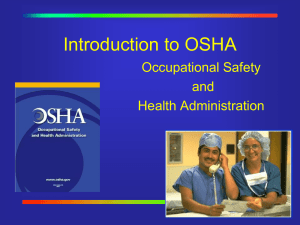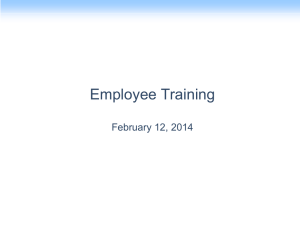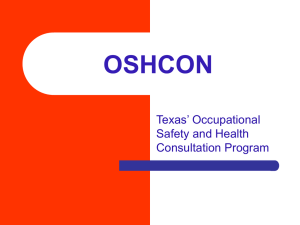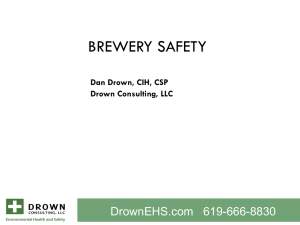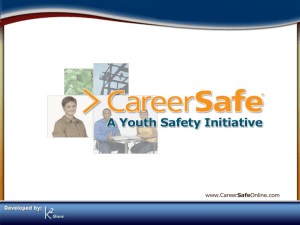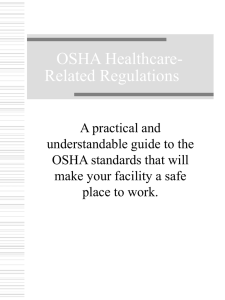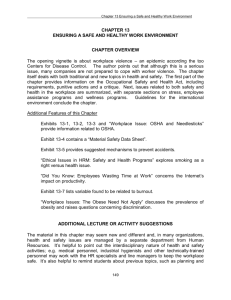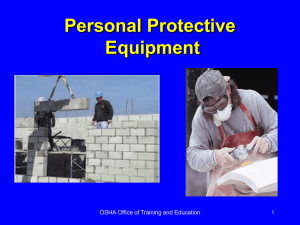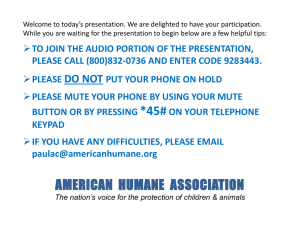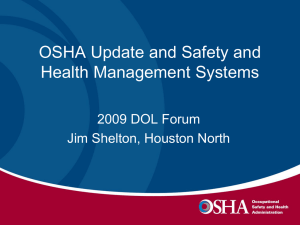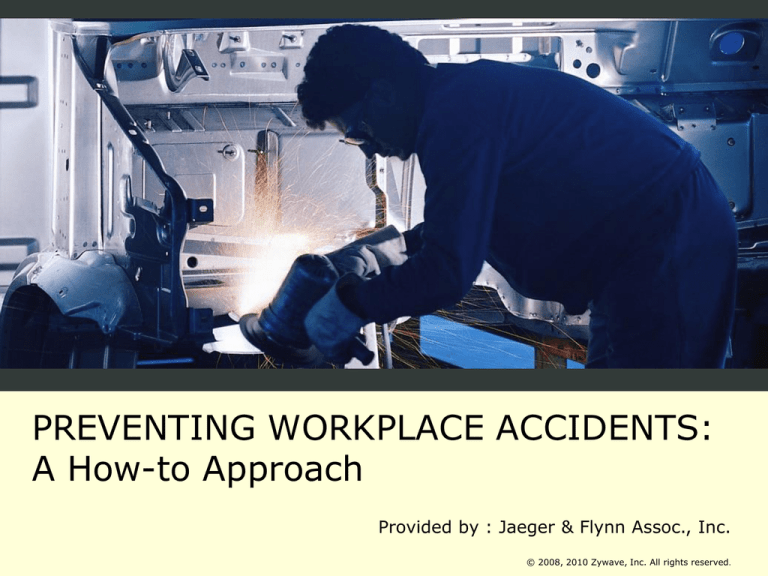
PREVENTING WORKPLACE ACCIDENTS:
A How-to Approach
Provided by : Jaeger & Flynn Assoc., Inc.
© 2008, 2010 Zywave, Inc. All rights reserved.
“Good loss control blends both the theoretical potential for
loss reduction, and the practical application of loss control
techniques with the customer’s corporate culture, operations
and future plans in mind.”
Program Objectives
Learn how to place safety next to production at
the top of the priority list.
Evaluate the impact of corporate/safety culture
on safety program effectiveness.
Identify the elements of an effective safety
program.
Develop a list of ideas for improving your
company’s safety program.
Identify a strategy for selling change and
getting more support for the safety effort.
Safety as a Priority
To make safety a top priority in your company,
you must…
• Remove subjectivity—Use objective tools to quantify
savings when implementing a safety program.
• Make safety an enterprise value, not just a cost center.
• Compete successfully for limited budget dollars.
• Change employee health and safety from reactive to
proactive.
Take safety out of the back room and
put it in the boardroom.
Safety as a Priority
Safety Professional/Facilitator Skills:
• People-oriented skills
• Management and business skills
• Language skills
• Flexibility for change
• Improved technical skills
Safety as a Priority
Past Business Model:
Present Business Model:
Hierarchy
Equates capital with power
National boundaries restrict
business initiatives and
relationships
Focus tasks around
individual
Flatters organization
Equates knowledge with
power
Global marketplace
Focus tasks around team
Safety as a Priority—Injury Statistics
According to OSHA…
On the downside:
75% of OSHA citations classified as serious, repeat, or willful.
50 workers are injured every minute.
14 workers die each day.
4.2 million nonfatal injuries and illnesses reported in 2008.
On the up side, with increased safety prevention programs:
Fatality statistics reduced by 50% since 1970.
Injury and illness rates reduced by 40% while employment
doubled (56/111 million), and the number of worksites has
doubled (3.5/7 million).
Overall fatal work injury rate was lower in 2009 than the rate
for any year since the fatality census in 1992.
Safety as a Priority—OSHA
General Duty Clause
Each employer:
• “Shall furnish to each of his employees employment and a
place of employment which are free from recognized hazards
that are causing or are likely to cause death or serious
physical harm to his employees;”
• “Shall comply with occupational safety and health standards
promulgated under this Act.”
Each Employee:
• “Shall comply with occupational safety and health standards
and all rules, regulations, and orders issued pursuant to this
Act which are applicable to his own actions and conduct.”
Safety as a Priority—OSHA Multi-Employer
Citation Policy
On multi-employer worksites
(in all industry sectors):
• More than one employer may be
cited for a hazardous condition that
violates an OSHA standard. A twostep process must be followed in
determining whether more than one
employer is to be cited.
Safety as a Priority—Injury Statistics
Time to Reflect…
What are your company’s injury stats?
How many people in your company know your
injury stats?
Do you have improvement goals?
How many know what your goals are?
Safety Culture
Why prevent workplace accidents?
The Heinrich Accident Model of 1931
Accidents are similar to a set of dominoes in which one action initiated a
sequence of actions. The falling dominoes represent the failure to
prepare for and prevent accidents and those that remain standing do so
only because of default.
Heinrich explained that the dominoes would eventually fall because they
are a consequence of one specific event. In this case, the consequence is
not creating a safety culture designed to prevent accidents.
DuPont Accident Theory
Accidents are preventable when the responsibility for actions are
assigned to a specific individual or group and that entity is made
accountable for his/her/their actions.
Accident losses and costs can be reduced if someone is made
accountable.
Safety Culture
Traditional Approach:
Engineering
Education
Enforcement
Comprehensive Approach:
Awareness through education
Compliance through enforcement
Engineering
Creating a safety culture
Safety management
Behavior modification
Safety Enforcement Example:
Require employees to wear safety
goggles while doing all tasks on
the plant floor.
Elements of a Safety Program
Critique your current
precautions by grading
preventative measures
from A through F.
Conduct a safety audit
of all preventative
measures and see how
they measure up to
current OSHA safety
recommendations.
Elements of a Safety Program
Simmons Method:
Calculate a representative number of incidents for:
Dispensary cases only
Medical Treatment
Lost Time
Determine the average for each incident type.
Use this average (for the case type) to determine
uninsured costs.
Elements of a Safety Program
Experience Mod Factor:
Comparison of actual losses to expected losses.
Benchmark Tool in which 1.00 is average.
Lower than 1.00 is better than average.
Higher than 1.00 is worse than average.
Measure dollars, not number of claims.
Based on a rolling three years.
Used as a multiplier for premium calculation.
Elements of a Safety Program
TYPE OF INSURANCE
LIMIT
Compensation Benefits
Statutory
Employer’s Liability
Bodily Injury By Accident – Each Accident
Bodily Injury By Disease – Policy Limit
Bodily Injury By Disease – Each Employee
$100,000
$500,000
$100,000
CODE
CLASSIFICATION
PAYROLL
RATE
PREMIUM
$3,100,000
4.98
$154,380
2812
Cabinet Workers
7380
Drivers
$175.00
5.17
$9,048
8810
Clerical
$800,000
0.25
$2,000
Estimated Manual Premium
$165,428
Estimated Standard Premium (Based on 1.16 Exp Mod)
$191,896
Estimated Premium Discount
($16,503)
Expense Constant
$210
ESTIMATED ANNUAL PREMIUM
$175,603
Elements of a Safety Program
Loss Sensitivity Analysis
MEDICAL &
INDEMNITY CLAIMS
MEDICAL ONLY CLAIMS
A
B
C
D
E
ACTUAL
INCURRED
LOSS
3 YR.
PREMIUM
ACTUAL INCURRED
LOSS, LESS 70%
3 YR.
PREMIUM
COST
SAVINGS
Column B less
Column D
$500
$1,135
$500 x .70 = $150
$378
($757)
$1,000
$2,334
$1,000 x .70 =
$300
$693
($1,641)
$2,000
$4,605
$2,000 x .70 =
$600
$1,389
($3,216)
Elements of a Safety Program
Workers’ Compensation Pricing Programs:
Guaranteed Cost
Flat/Level Dividend
Sliding Scale/Variable
Dividend
Retrospective (Retro)
Plan
Self-Insured
Deductibles
Elements of a Safety Program
OSHA’s Draft Proposed Rule: 29 CFR 1900.1
• The purpose of this rule is to reduce the number of jobrelated fatalities, illnesses and injuries. The rule will
accomplish this by requiring employers to establish a
workplace safety and health program to ensure compliance
with OSHA standards and the General Duty Clause of the Act
(Section 5(a)(1)).
• This rule applies to hazards covered by the General Duty
Clause and by OSHA standards.
Ideas for Improvement
Develop a list of ideas for improving your company’s
safety effort.
“Selling” Strategies
Identify a strategy for selling change internally and
getting more support for the safety effort.



